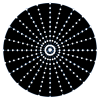Short-term changes in light distortion in orthokeratology subjects
- PMID: 25699265
- PMCID: PMC4324896
- DOI: 10.1155/2015/278425
Short-term changes in light distortion in orthokeratology subjects
Erratum in
-
Corrigendum to "Short-Term Changes in Light Distortion in Orthokeratology Subjects".Biomed Res Int. 2015;2015:458706. doi: 10.1155/2015/458706. Epub 2015 Aug 2. Biomed Res Int. 2015. PMID: 26345144 Free PMC article. No abstract available.
Abstract
Purpose: Quantifying adaptation to light distortion of subjects undergoing orthokeratology (OK) for myopia during the first month of treatment.
Methods: Twenty-nine healthy volunteers (age: 22.34 ± 8.08 years) with mean spherical equivalent refractive error -2.10 ± 0.93D were evaluated at baseline and days 1, 7, 15, and 30 of OK treatment. Light distortion was determined using an experimental prototype. Corneal aberrations were derived from corneal topography for different pupil sizes. Contrast sensitivity function (CSF) was analyzed for frequencies of 1.50, 2.12, 3.00, 4.24, 6.00, 8.49, 12.00, 16.97, and 24.00 cpd under photopic conditions.
Results: Average monocular values of all light distortion parameters measured increased significantly on day 1, returning to baseline after 1 week (P < 0.05 in all cases). Spherical-like aberration stabilized on day 7 for all pupil diameters, while coma-like for smaller pupils only. CSF was significantly reduced on day 1 for all spatial frequencies except for 1.5 cpd, returning to baseline afterwards. Significant correlation was found between light distortion and contrast sensitivity for middle and high frequencies (P < 0.05) after 15 days.
Conclusion: Despite consistently increased levels of corneal aberrations, light distortion tends to return to baseline after one week of treatment, suggesting that neural adaptation is capable of overcoming optical quality degradation.
Figures




Similar articles
-
Reversibility of effects of orthokeratology on visual acuity, refractive error, corneal topography, and contrast sensitivity.Eye Contact Lens. 2008 Jul;34(4):224-8. doi: 10.1097/ICL.0b013e318165d501. Eye Contact Lens. 2008. PMID: 18787430
-
Long-term follow-up of orthokeratology corneal reshaping using wavefront aberrometry and contrast sensitivity.Eye Contact Lens. 2008 May;34(3):140-5. doi: 10.1097/ICL.0b013e318145ab5d. Eye Contact Lens. 2008. PMID: 18463478
-
Recovery evaluation of induced changes in higher order aberrations from the anterior surface of the cornea for different pupil sizes after cessation of corneal refractive therapy.Cornea. 2013 Apr;32(4):e16-20. doi: 10.1097/ICO.0b013e318261eb66. Cornea. 2013. PMID: 23132438
-
Corneal versus ocular aberrations after overnight orthokeratology.Optom Vis Sci. 2013 May;90(5):439-47. doi: 10.1097/OPX.0b013e31828ec594. Optom Vis Sci. 2013. PMID: 23538436
-
Influence of induced decentered orthokeratology lens on ocular higher-order wavefront aberrations and contrast sensitivity function.J Cataract Refract Surg. 2009 Nov;35(11):1918-26. doi: 10.1016/j.jcrs.2009.06.018. J Cataract Refract Surg. 2009. PMID: 19878824
Cited by
-
Time Course of Perceived Visual Distortion and Axial Length Growth in Myopic Children Undergoing Orthokeratology.Front Neurosci. 2021 Oct 13;15:693217. doi: 10.3389/fnins.2021.693217. eCollection 2021. Front Neurosci. 2021. PMID: 34720848 Free PMC article.
-
Interaction between Corneal and Internal Ocular Aberrations Induced by Orthokeratology and Its Influential Factors.Biomed Res Int. 2017;2017:3703854. doi: 10.1155/2017/3703854. Epub 2017 Aug 6. Biomed Res Int. 2017. PMID: 28845432 Free PMC article.
-
Orthokeratology: clinical utility and patient perspectives.Clin Optom (Auckl). 2017 Feb 7;9:33-40. doi: 10.2147/OPTO.S104507. eCollection 2017. Clin Optom (Auckl). 2017. PMID: 30214358 Free PMC article. Review.
-
Peripheral Defocus in Orthokeratology Myopia Correction: Systematic Review and Meta-Analysis.J Clin Med. 2025 Jan 21;14(3):662. doi: 10.3390/jcm14030662. J Clin Med. 2025. PMID: 39941333 Free PMC article. Review.
-
Blur Detection Sensitivity Increases in Children Using Orthokeratology.Front Neurosci. 2021 Mar 12;15:630844. doi: 10.3389/fnins.2021.630844. eCollection 2021. Front Neurosci. 2021. PMID: 33790734 Free PMC article.
References
-
- Lu F., Simpson T., Sorbara L., Fonn D. Corneal refractive therapy with different lens materials, part 2: effect of oxygen transmissibility on corneal shape and optical characteristics. Optometry & Vision Science. 2007;84:349–356. - PubMed
Publication types
MeSH terms
LinkOut - more resources
Full Text Sources
Other Literature Sources
Medical

